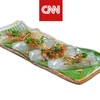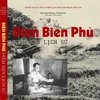 Every late September and early October, residents in Me Tri village of Hanoi's Nam Tu Liem district become busy working from early morning until late evening to make fragrant and glutinous 'com' for the next day. Me Tri is one of the few remaining traditional 'com' making villages, aside from Vong and Lu. For generations, traditional culinary villages in the capital city have created delicious dishes and contributed to the culinary ecosystem of Vietnam. Among those dishes, 'com' is a must-have snack for Hanoians in autumn. To many, the green, fragrant, and light sweet flakes seem to contain the entire quintessence of nature. (Photo: VietnamPlus)
Every late September and early October, residents in Me Tri village of Hanoi's Nam Tu Liem district become busy working from early morning until late evening to make fragrant and glutinous 'com' for the next day. Me Tri is one of the few remaining traditional 'com' making villages, aside from Vong and Lu. For generations, traditional culinary villages in the capital city have created delicious dishes and contributed to the culinary ecosystem of Vietnam. Among those dishes, 'com' is a must-have snack for Hanoians in autumn. To many, the green, fragrant, and light sweet flakes seem to contain the entire quintessence of nature. (Photo: VietnamPlus)  When the pungent scent of milk flowers spreads across the capital city, usually in late September, signalling the arrival of autumn, Me Tri villagers become busier than average as they have to work continuously overnight so that fragrant, glutinous, and warm rice flakes can reach buyers in the early morning. 'Com' is made of young sticky rice reaped in either 'chiem' (harvested in the fifth lunar month) or 'mua' (harvested in the 10th lunar month) crops, but it is most delicious when the ingredient is 'nep cai hoa vang', an indigenous rice variety. People in Hanoi often use the rice of the 'mua' crop to make 'com' as it will give the dish a better taste. (Photo: VietnamPlus)
When the pungent scent of milk flowers spreads across the capital city, usually in late September, signalling the arrival of autumn, Me Tri villagers become busier than average as they have to work continuously overnight so that fragrant, glutinous, and warm rice flakes can reach buyers in the early morning. 'Com' is made of young sticky rice reaped in either 'chiem' (harvested in the fifth lunar month) or 'mua' (harvested in the 10th lunar month) crops, but it is most delicious when the ingredient is 'nep cai hoa vang', an indigenous rice variety. People in Hanoi often use the rice of the 'mua' crop to make 'com' as it will give the dish a better taste. (Photo: VietnamPlus)  'Com' production in Me Tri village is more than 100 years old. Together with 16 others, it was recognised as part of the national intangible cultural heritage by the Ministry of Culture, Sports and Tourism in 2019. Visitors to Me Tri village these days can smell the soft fragrance of young rice in every corner. There are two 'com' making seasons in Me Tri village, corresponding to the rice crops of 'chiem' and 'mua'. The 'mua' crop lasts from around the middle of the seventh lunar month to the ninth lunar month. Setting foot in 'com' making villages this season, visitors can hear rice pounding sounds and smell the scent of young rice flakes from local households. (Photo: VietnamPlus)
'Com' production in Me Tri village is more than 100 years old. Together with 16 others, it was recognised as part of the national intangible cultural heritage by the Ministry of Culture, Sports and Tourism in 2019. Visitors to Me Tri village these days can smell the soft fragrance of young rice in every corner. There are two 'com' making seasons in Me Tri village, corresponding to the rice crops of 'chiem' and 'mua'. The 'mua' crop lasts from around the middle of the seventh lunar month to the ninth lunar month. Setting foot in 'com' making villages this season, visitors can hear rice pounding sounds and smell the scent of young rice flakes from local households. (Photo: VietnamPlus)  To make 'com', villagers must get up at 3am to start working. The rice ingredient is now sourced from not only Me Tri or neighbouring areas but also various provinces in the northern region, such as Bac Ninh and Phu Tho. The charming scent of young rice can grasp the attention of any passers-by when they set foot here this time of the year. Making a perfect batch of young sticky rice flakes takes many meticulous steps. Only plump and fragrant grains are chosen. After harvesting, young sticky rice is dried in the sun, straw and empty grains are sifted out, and the remaining grains are washed in water. (Photo: VietnamPlus)
To make 'com', villagers must get up at 3am to start working. The rice ingredient is now sourced from not only Me Tri or neighbouring areas but also various provinces in the northern region, such as Bac Ninh and Phu Tho. The charming scent of young rice can grasp the attention of any passers-by when they set foot here this time of the year. Making a perfect batch of young sticky rice flakes takes many meticulous steps. Only plump and fragrant grains are chosen. After harvesting, young sticky rice is dried in the sun, straw and empty grains are sifted out, and the remaining grains are washed in water. (Photo: VietnamPlus)  Visitors can witness the vibrant scene of 'com' production coming to Me Tri these days. The light sweet scent of young rice spreads in the air and can win the heart of every people. After being harvested, dried in the sun and washed, young sticky rice grains are roasted in a pan over a small fire and stirred constantly. When the green grains turn white, release fragrance, and have their husk easily removed, they are properly cooked. After that, the husked rice will be pounded and continued to be sifted to remove the remaining cover. Pounding and sifting must be carried out at least three times to make a clean batch of 'com'. (Photo: VietnamPlus)
Visitors can witness the vibrant scene of 'com' production coming to Me Tri these days. The light sweet scent of young rice spreads in the air and can win the heart of every people. After being harvested, dried in the sun and washed, young sticky rice grains are roasted in a pan over a small fire and stirred constantly. When the green grains turn white, release fragrance, and have their husk easily removed, they are properly cooked. After that, the husked rice will be pounded and continued to be sifted to remove the remaining cover. Pounding and sifting must be carried out at least three times to make a clean batch of 'com'. (Photo: VietnamPlus)  This time of the year is the peak period of the year's biggest 'com' season. The stoves for roasting 'com' are covered with coal residues, but firewood is used as fuel, not coal. Meanwhile, the roasting pans are often made from cast iron, ensuring each grain is not overcooked but soft, sticky, and fragrant. Hanoi is believed to be most beautiful in autumn, which is also the season of 'com'. This speciality can be eaten directly or enjoyed with bananas as a snack. It can also be mixed with other food ingredients to create a variety of tasty dishes, including cha com (Vietnamese com sausage) and com xao (browned green sticky rice). (Photo: VietnamPlus)
This time of the year is the peak period of the year's biggest 'com' season. The stoves for roasting 'com' are covered with coal residues, but firewood is used as fuel, not coal. Meanwhile, the roasting pans are often made from cast iron, ensuring each grain is not overcooked but soft, sticky, and fragrant. Hanoi is believed to be most beautiful in autumn, which is also the season of 'com'. This speciality can be eaten directly or enjoyed with bananas as a snack. It can also be mixed with other food ingredients to create a variety of tasty dishes, including cha com (Vietnamese com sausage) and com xao (browned green sticky rice). (Photo: VietnamPlus)  Making a perfect batch of young sticky rice flakes takes many meticulous steps. The 'com' production in Me Tri village dates back more than a century. Residents in Me Tri village say once the 'com' making season comes. All family members are involved in making this speciality, working from 4 am until midnight. The finished product will be wrapped in lotus leaves so that the scent of both mixes. 'Com' lovers usually rub the grains in lotus leaves to enjoy that scent. People often eat 'com' directly or use it as an ingredient to make various dishes, such as cha com (Vietnamese com sausage) and com xao (browned green sticky rice). (Photo: VietnamPlus)
Making a perfect batch of young sticky rice flakes takes many meticulous steps. The 'com' production in Me Tri village dates back more than a century. Residents in Me Tri village say once the 'com' making season comes. All family members are involved in making this speciality, working from 4 am until midnight. The finished product will be wrapped in lotus leaves so that the scent of both mixes. 'Com' lovers usually rub the grains in lotus leaves to enjoy that scent. People often eat 'com' directly or use it as an ingredient to make various dishes, such as cha com (Vietnamese com sausage) and com xao (browned green sticky rice). (Photo: VietnamPlus)  The ingredient for 'com' making is the grains whose content has just turned from a liquid into a solid so that the finished product can be sticky and sweet enough. Notable dishes made from 'com' include 'com xao' (young sticky rice flakes cooked with sugar), 'cha com' (rice flake meatballs), 'xoi com' (steamed young sticky rice flakes), 'banh com' (green sticky rice flake cakes), or 'che com' (sweet tapioca soup with sticky rice flakes). In particular, 'banh com' is a must-try delicacy and an indispensable part of every engagement ceremony in the capital city. The cake is made from young sticky rice flakes filled with mung bean, coconut, or candied lotus seeds. (Photo: VietnamPlus)
The ingredient for 'com' making is the grains whose content has just turned from a liquid into a solid so that the finished product can be sticky and sweet enough. Notable dishes made from 'com' include 'com xao' (young sticky rice flakes cooked with sugar), 'cha com' (rice flake meatballs), 'xoi com' (steamed young sticky rice flakes), 'banh com' (green sticky rice flake cakes), or 'che com' (sweet tapioca soup with sticky rice flakes). In particular, 'banh com' is a must-try delicacy and an indispensable part of every engagement ceremony in the capital city. The cake is made from young sticky rice flakes filled with mung bean, coconut, or candied lotus seeds. (Photo: VietnamPlus)  A man adds wood to a stove for roasting rice. 'Com' of Me Tri in particular, and of Hanoi in general, is an indispensable dish in the culinary culture of Vietnam. The dish is considered a gift of the wet rice culture and the quintessence of nature. 'Com' and 'banh com' have also become special souvenirs visitors bring home whenever they set foot in the capital city. For most Hanoians, 'com' and its related products are among the capital's most important flavours of autumn, packed full of nostalgia. It is a symbol of gastronomy and elegance due to its signature colour, flexibility and flavour that similar products from nowhere else can compete with. (Photo: VietnamPlus)
A man adds wood to a stove for roasting rice. 'Com' of Me Tri in particular, and of Hanoi in general, is an indispensable dish in the culinary culture of Vietnam. The dish is considered a gift of the wet rice culture and the quintessence of nature. 'Com' and 'banh com' have also become special souvenirs visitors bring home whenever they set foot in the capital city. For most Hanoians, 'com' and its related products are among the capital's most important flavours of autumn, packed full of nostalgia. It is a symbol of gastronomy and elegance due to its signature colour, flexibility and flavour that similar products from nowhere else can compete with. (Photo: VietnamPlus)  Autumn has arrived in Hanoi with gentle breezes caressing street corners, replacing the summer heat. It is the ideal time for making 'com'. Many have said staying in the capital without savouring 'com' would be a major shortcoming of a Hanoi experience. Roasting 'com' is considered an art in which makers must estimate when the grains reach the desired stickiness level. The traditional roasting method uses wood, not coal, as fuel. This process requires a big fire initially, but the fire should be smaller in the latter stage. Each batch of 'com' needs to be roasted for more than two hours. (Photo: VietnamPlus)
Autumn has arrived in Hanoi with gentle breezes caressing street corners, replacing the summer heat. It is the ideal time for making 'com'. Many have said staying in the capital without savouring 'com' would be a major shortcoming of a Hanoi experience. Roasting 'com' is considered an art in which makers must estimate when the grains reach the desired stickiness level. The traditional roasting method uses wood, not coal, as fuel. This process requires a big fire initially, but the fire should be smaller in the latter stage. Each batch of 'com' needs to be roasted for more than two hours. (Photo: VietnamPlus)  During the roasting process, makers must constantly adjust the fire to ensure that the grains are beautiful and neither uncooked nor broken. They can use their fingers to press the grains to decide whether the rice is soft and sticky enough. The young stick rice flakes can be made from various rice varieties, but Me Tri villagers only use 'nep cai hoa vang', an indigenous rice variety, to make their speciality. The delicate but fragrant green grains reflect the labour, love and passion of the rice growers and 'com' producers. It can contain the essence of the earth, the heaven, and the scent of sunshine and wind. (Photo: VietnamPlus)
During the roasting process, makers must constantly adjust the fire to ensure that the grains are beautiful and neither uncooked nor broken. They can use their fingers to press the grains to decide whether the rice is soft and sticky enough. The young stick rice flakes can be made from various rice varieties, but Me Tri villagers only use 'nep cai hoa vang', an indigenous rice variety, to make their speciality. The delicate but fragrant green grains reflect the labour, love and passion of the rice growers and 'com' producers. It can contain the essence of the earth, the heaven, and the scent of sunshine and wind. (Photo: VietnamPlus)  When roasting starts, a big fire is needed, but a smaller fire is necessary when grains become half-cooked since if the fire is too big, rice will be burned, but if the fire is too small, the finished product will not be sticky enough. At this time of the year, the villages become busier than normal as residents have to work continuously overnight so that fragrant, glutinous, and warm rice flakes can reach buyers in the early morning. Setting foot in Me Tri and other 'com' making villages this season, visitors can hear rice pounding sounds and smell the scent of young rice flakes from local households. (Photo: VietnamPlus)
When roasting starts, a big fire is needed, but a smaller fire is necessary when grains become half-cooked since if the fire is too big, rice will be burned, but if the fire is too small, the finished product will not be sticky enough. At this time of the year, the villages become busier than normal as residents have to work continuously overnight so that fragrant, glutinous, and warm rice flakes can reach buyers in the early morning. Setting foot in Me Tri and other 'com' making villages this season, visitors can hear rice pounding sounds and smell the scent of young rice flakes from local households. (Photo: VietnamPlus)  People have applied machinery to 'com' production, so this strenuous process now consumes less labour. Legend has it that one autumn 1,000 years ago, when farmers in Vong, another famous 'com' making village in Hanoi, were going to harvest sticky rice, a storm came and caused huge damage to the crops. Villagers tried to pick the remaining green rice from the storm-torn paddy fields and brought it home to stir fry. The rice became a new dish and helped them survive hard days. Through generations, locals continually improved 'com' processing until they found it tasted so good and even went beyond the village to win the favour of all people. Since then, 'com' has been made every autumn. (Photo: VietnamPlus)
People have applied machinery to 'com' production, so this strenuous process now consumes less labour. Legend has it that one autumn 1,000 years ago, when farmers in Vong, another famous 'com' making village in Hanoi, were going to harvest sticky rice, a storm came and caused huge damage to the crops. Villagers tried to pick the remaining green rice from the storm-torn paddy fields and brought it home to stir fry. The rice became a new dish and helped them survive hard days. Through generations, locals continually improved 'com' processing until they found it tasted so good and even went beyond the village to win the favour of all people. Since then, 'com' has been made every autumn. (Photo: VietnamPlus)  Roasted rice needs to be pounded and sifted five to seven times to be completely free of the husk. As the rice farming area in Me Tri has been shrinking, and the output is not enough for producing 'com', villagers have had to source the material from nearby localities. Making young sticky rice flakes is a meticulous process in which producers invest their wholehearted efforts. Skill and hard work are needed to make authentic 'com', which must be flat, lime-green, chewy, sticky and smell pleasant like the scent of green rice. The speciality is sold by street vendors or in shops. It can also be found on many hotels in Hanoi's breakfast or buffet menus. (Photo: VietnamPlus)
Roasted rice needs to be pounded and sifted five to seven times to be completely free of the husk. As the rice farming area in Me Tri has been shrinking, and the output is not enough for producing 'com', villagers have had to source the material from nearby localities. Making young sticky rice flakes is a meticulous process in which producers invest their wholehearted efforts. Skill and hard work are needed to make authentic 'com', which must be flat, lime-green, chewy, sticky and smell pleasant like the scent of green rice. The speciality is sold by street vendors or in shops. It can also be found on many hotels in Hanoi's breakfast or buffet menus. (Photo: VietnamPlus)  Roasted rice is being sifted. From the beginning of a rice crop, Me Tri villagers have to buy high-quality rice seeds from nearby areas such as Me Linh, Soc Son, and Vinh Phuc, contract farmers to grow the rice, and purchase the grains when the harvest time comes. 'Com' can be eaten directly or enjoyed with bananas as a snack. It can also be mixed with other ingredients to create a variety of tasty dishes, including 'cha com' (rice flake meatballs), 'com xao' (young sticky rice flakes cooked with sugar), 'xoi com' (steamed young sticky rice flakes), 'banh com' (green sticky rice flake cakes), or 'che com' (sweet tapioca soup with sticky rice flakes). (Photo: VietnamPlus)
Roasted rice is being sifted. From the beginning of a rice crop, Me Tri villagers have to buy high-quality rice seeds from nearby areas such as Me Linh, Soc Son, and Vinh Phuc, contract farmers to grow the rice, and purchase the grains when the harvest time comes. 'Com' can be eaten directly or enjoyed with bananas as a snack. It can also be mixed with other ingredients to create a variety of tasty dishes, including 'cha com' (rice flake meatballs), 'com xao' (young sticky rice flakes cooked with sugar), 'xoi com' (steamed young sticky rice flakes), 'banh com' (green sticky rice flake cakes), or 'che com' (sweet tapioca soup with sticky rice flakes). (Photo: VietnamPlus)  After roasted, rice is pounded until grains are flat, no longer stick to one another and remain unbroken. The ideal ratio is 10kg of unmilled rice, generating 1.6 - 1.7kg of 'com'. 'Com' production is a meticulous process. People only select plump and fragrant grains to make this delicacy. After harvesting, young sticky rice is dried in the sun, straw and empty grains are sifted out, and the remaining grains are washed in water. After that, they are roasted in a pan and stirred constantly. They are properly cooked when green grains turn white, release fragrance, and have their husk easily removed. Later, rice will be pounded and continued to be sifted to remove the remaining husk. (Photo: VietnamPlus)
After roasted, rice is pounded until grains are flat, no longer stick to one another and remain unbroken. The ideal ratio is 10kg of unmilled rice, generating 1.6 - 1.7kg of 'com'. 'Com' production is a meticulous process. People only select plump and fragrant grains to make this delicacy. After harvesting, young sticky rice is dried in the sun, straw and empty grains are sifted out, and the remaining grains are washed in water. After that, they are roasted in a pan and stirred constantly. They are properly cooked when green grains turn white, release fragrance, and have their husk easily removed. Later, rice will be pounded and continued to be sifted to remove the remaining husk. (Photo: VietnamPlus)  Me Tri villagers carefully examine every batch of 'com' before the product is sold. Producing young green rice flakes is one of the oldest traditional professions in Hanoi. It has been preserved for generations and plays an important part in the diverse and flavourful cuisine of the capital city. Me Tri village and Vong village are renowned for making 'com'. The craft in Me Tri has a history of more than a century. Experiencing many ups and downs, the profession still exists, has developed and has changed a lot. In the past, local people only produced 'com' in one crop per year, but now they make it all year round. (Photo: VietnamPlus)
Me Tri villagers carefully examine every batch of 'com' before the product is sold. Producing young green rice flakes is one of the oldest traditional professions in Hanoi. It has been preserved for generations and plays an important part in the diverse and flavourful cuisine of the capital city. Me Tri village and Vong village are renowned for making 'com'. The craft in Me Tri has a history of more than a century. Experiencing many ups and downs, the profession still exists, has developed and has changed a lot. In the past, local people only produced 'com' in one crop per year, but now they make it all year round. (Photo: VietnamPlus)  People in Me Tri village have produced 'com' for over a century. The stoves for roasting 'com' are covered with coal residues, but firewood is used as fuel, not coal. Meanwhile, the roasting pans are often made from cast iron, ensuring each grain is not overcooked but soft, sticky, and fragrant. The finished product will be wrapped in lotus leaves so that the scent of both mixes with each other and its softness is retained. With its special sweetness and nutty flavour further enhanced by lotus leaves, 'com' is a delicacy embedded with the quintessence of Hanoi's original cuisine that every visitor to the capital city should try. (Photo: VietnamPlus)
People in Me Tri village have produced 'com' for over a century. The stoves for roasting 'com' are covered with coal residues, but firewood is used as fuel, not coal. Meanwhile, the roasting pans are often made from cast iron, ensuring each grain is not overcooked but soft, sticky, and fragrant. The finished product will be wrapped in lotus leaves so that the scent of both mixes with each other and its softness is retained. With its special sweetness and nutty flavour further enhanced by lotus leaves, 'com' is a delicacy embedded with the quintessence of Hanoi's original cuisine that every visitor to the capital city should try. (Photo: VietnamPlus)  'Com' has become an indispensable part of Vietnamese cuisine whenever autumn comes. Making 'com' is hard and meticulous work. Still, the application of machinery has helped ease the workload in several production steps, thus saving time and reducing production costs but still ensuring quality. The young sticky rice flakes of Me Tri are not only consumed domestically but also exported to other countries and have become a favourite gift for international tourists when they set foot in the capital city. 'Com' is considered a must-have snack for Hanoians in autumn. To many, the green, fragrant, and light sweet flakes seem to hold the entire quintessence of nature. (Photo: VietnamPlus)
'Com' has become an indispensable part of Vietnamese cuisine whenever autumn comes. Making 'com' is hard and meticulous work. Still, the application of machinery has helped ease the workload in several production steps, thus saving time and reducing production costs but still ensuring quality. The young sticky rice flakes of Me Tri are not only consumed domestically but also exported to other countries and have become a favourite gift for international tourists when they set foot in the capital city. 'Com' is considered a must-have snack for Hanoians in autumn. To many, the green, fragrant, and light sweet flakes seem to hold the entire quintessence of nature. (Photo: VietnamPlus)  Many families in Me Tri village have produced 'com' for three-four generations. Com is the main ingredient of many dishes. Among them, 'banh com' (green sticky rice flake cakes) is a must-try speciality and an indispensable part of every engagement ceremony in the capital city. The cake is made from 'com' filled with mung bean, coconut flakes or candied lotus seeds. Meanwhile, another highlight is 'cha com' (rice flake meatballs). To make this dish, the mixture of 'com' and lean shoulder pork, added with seasoning, is kneaded and divided into small pieces and steamed for 15 to 20 minutes. Finally, it is fried until it becomes light brown on both sides. (Photo: VietnamPlus)
Many families in Me Tri village have produced 'com' for three-four generations. Com is the main ingredient of many dishes. Among them, 'banh com' (green sticky rice flake cakes) is a must-try speciality and an indispensable part of every engagement ceremony in the capital city. The cake is made from 'com' filled with mung bean, coconut flakes or candied lotus seeds. Meanwhile, another highlight is 'cha com' (rice flake meatballs). To make this dish, the mixture of 'com' and lean shoulder pork, added with seasoning, is kneaded and divided into small pieces and steamed for 15 to 20 minutes. Finally, it is fried until it becomes light brown on both sides. (Photo: VietnamPlus)  Whenever coming to Hanoi, visitors should stop by Me Tri village to buy a small bundle of 'com' as a gift for their families and friends. This village is one of the few remaining traditional 'com' making villages, aside from Vong and Lu. In the past, the village was well-known for its high-quality rice, which was praised by a king in the Ly Dynasty (1010 - 1225). The king then renamed its original name of Anh Son into Me Tri, which means Pool of Rice. The delicacy is now available all year round, but it is believed to have the best taste and is considered an identity of Hanoi in autumn. (Photo: VietnamPlus)
Whenever coming to Hanoi, visitors should stop by Me Tri village to buy a small bundle of 'com' as a gift for their families and friends. This village is one of the few remaining traditional 'com' making villages, aside from Vong and Lu. In the past, the village was well-known for its high-quality rice, which was praised by a king in the Ly Dynasty (1010 - 1225). The king then renamed its original name of Anh Son into Me Tri, which means Pool of Rice. The delicacy is now available all year round, but it is believed to have the best taste and is considered an identity of Hanoi in autumn. (Photo: VietnamPlus) VNA



















